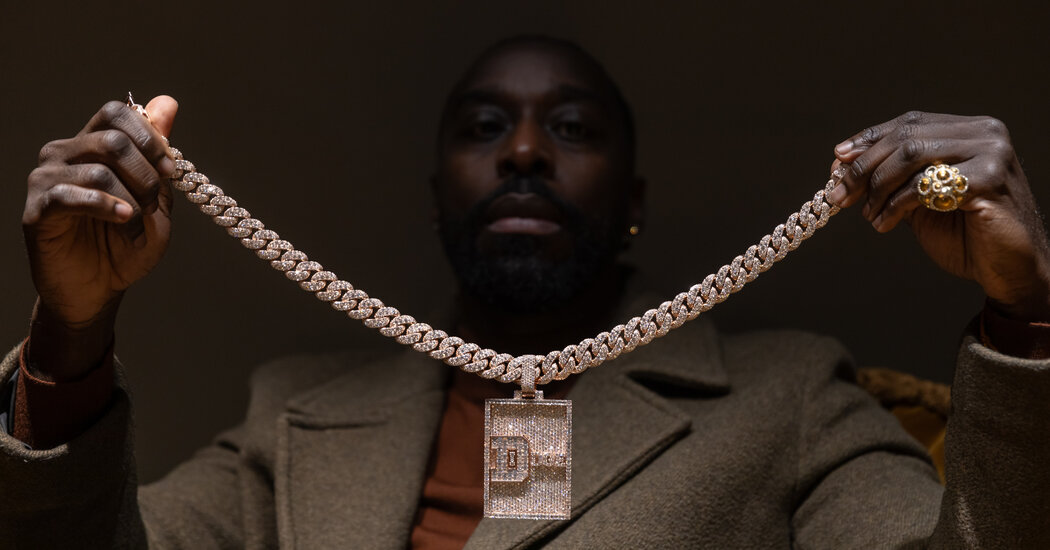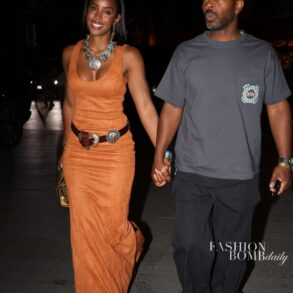
The rectangular pieces may be smaller than those often worn by hip-hop stars, but they still allow wearers to express themselves without saying a word.
What would Benedictine monks from the seventh century and the Notorious B.I.G. have in common? Not a lot, other than their plaque pendants.
Today the flat rectangular pieces — some so large they look like motorcycle license plates on chains — include a diamond-studded “Live Yours” plaque worn by the British rapper Central Cee and lots of variations on nameplates. For example, the rapper DaBaby, born Jonathan Lyndale Kirk, wears an enormous “Kirk” plaque, while the singer and rapper Bia has large diamond-set pendants with Bia and her birth name, Bianca, in rectangular formats.
Distant but no less desirable relatives of these giant, diamond-heavy pendants are in the current collections from the French jeweler Marie Lichtenberg, Eugenie Niarchos’s brand Venyx, the Italian designer Francesca Villa and even Victoire de Castellane’s most recent high jewelry collection at Dior, in vibrant, often enameled color and referencing a variety of ideas from surrealist artworks to belief systems.
“They’re a bit like a tattoo,” said Chiefer Appiah, a jeweler who opened his first boutique in September in London’s Mayfair neighborhood after operating a private showroom in the same area for several years. “They allow you to say something about yourself without speaking.”
On the contemporary jewelry scene, early hip-hop artists were among the first to wear plaques, a style that Vikki Tobak, author of the 2022 book “Ice Cold; A Hip Hop Jewelry History,” said emerged from New York’s Black and Latino communities.
“The community jewelry stores that served the Black and Latino communities in the ’80s were selling the plaque-style pendants with saints and other spiritual imagery,” she said. “Inevitably all that sort of imagery and iconography translated into folks from the hip-hop community wearing them.
“And because in the hip-hop community there’s such a culture of remixing and intense customization and this great need to express ones’ identity and be ‘one of one,’ you started to see these pendants being worn as a way to tell people who you were.”
Ms. Tobak said the rapper B.I.G., who also performed as Biggie Smalls until he was killed in a drive-by shooting in 1997, was the first hip-hop artist to popularize custom pendants called Jesus Pieces. He had commissioned Tito Caicedo, the New York diamond district jeweler also known as Manny, to make three gold and diamond busts of Jesus wearing a crown of thorns. (Several other names are often mentioned in connection with the origin of the popular Pieces — and Ms. Tobak noted that, to purists, the originators were two New York Latino street legends: Rapp from the Paid in Full posse and “a guy who everyone knew as Jesus out of Brooklyn, a.k.a. ‘Puerto Rican Jesus.’”)
Mr. Appiah, whose Instagram account shows jumbo plaque-wearing clients from the British two-time heavyweight boxing champion Anthony Joshua to the American rapper Nine, said his memories of his London childhood go back to that era, too. “Being a kid in the 1980s,” he said, “a lot of the rappers like Slick Rick and Grandmaster Flash really popularized big chains and big pendants.
“They were like a canvas to show the world what you were about as soon as you walked into a room, showing your name or your brand in diamonds.”
There was a lull in the trend in the early 2000s, he recalled, but then he saw the rapper Nas wearing huge pendants, “and the trend came back again.”
These days, Mr. Appiah sees the plaque pendant as a place to paint a story — albeit with diamonds. “The bigger the canvas, the more you can say with it,” he said.
A Devotional Design
Diamonds, however, were not part of what some jewelry experts say was the earliest version of the style: a long piece of fabric, with a hole in the middle so it could be pulled over the head, worn by monks in the Middle Ages to protect their robes at work. Eventually it became what Catholics now call a scapular: two small rectangles of fabric, usually printed with an image of Jesus or the Virgin Mary, joined by cords or straps. Once it is put on over the head, one square hangs in front, the other in back, and the cords sit on the shoulders.
Ms. Lichtenberg’s Scapulaire necklaces borrow their name from that devotional item, but it was their form, not their meaning, that interested her — even if it is on a smaller scale.
“The scapular is workable on two flat surfaces, as well as its edges,” she wrote in a message, giving her 12 different surfaces between the two pendants — front, back and edges — to decorate or add images or words. “It was interesting for me to explore this more conventional form and add our poetry and complexity to it.”
Her Believe necklace, for example, features two pendants: the smaller one, with an alien’s face surrounded by 16 small diamonds, hangs above the larger one, which shows the planet Saturn and stars detailed with seven diamonds and 12 sapphires. The necklace, which is 11,000 euros ($11,985), has an 18-karat gold chain 80 centimeters (31.5 inches) long.
The Surrealist artist Man Ray was the inspiration for Venyx’s new nine-piece limited edition collection, which includes two pendants by the London-based brand. One plaque in 18-karat gold and enamel depicts bright red lips floating over a mountain landscape ($3,900), a homage to Man Ray’s 1933 painting “The Lovers.”
The other — drawn from his 1932 photograph “Larmes” (in English, “Tears”) — is a white gold rectangle with a heavily mascaraed eye crying a diamond tear drop, rendered in enamel, mother-of-pearl, and black rhodium ($14,635). (The Gagosian Gallery is the retail partner for the collection, on display at its New York store until Dec. 22.)
“I love the idea of wearing a little painting around your neck,” Ms. Niarchos, Venyx’s founder and designer, said in a phone interview from New York, where she had attended the collection’s opening. “I’ve been doing plaques for a few years now. I did a flat slab of opal and then put little gold stars on it, but I’ve done sunsets and moonscapes using the inlay technique.”
Equally art-like is the postcard range from the Singapore brand Maison Tjoeng, whose designer, Yasmin Tjoeng, has rendered yesteryear-inspired postcard scenes as plaques, enhancing the enamel paintings in frames of gold, diamonds and colored gems. The Capri pendant, for example, has a beach scene with striped sun umbrellas and the Italian island’s famous rocky shoreline in the background, framed by baguette-cut diamonds and cabochon aquamarines ($15,885).
Even high jewelry recently made use of the plaque style, though on a more conservative scale.
At Dior, Ms. de Castellane’s Les Jardins de la Couture high jewelry collection, introduced in May at Lake Como, Italy, connected flat panels of mother-of-pearl to create a collar-style necklace. The plaques are decorated with whimsical scenes of flowers and clouds, rainbows and suns crafted from diamonds, colored gems and black lacquer over gold and platinum — producing a kind of storyboard in precious materials to wrap around the neck (price on application).
For minimalists, the military inspired dogtag-style pendant might be more appealing. Tiffany & Company has a line of Makers I.D. Tag pendants in 18 karat gold ($6,600) and sterling silver. And A Vanitas, a new collaboration between the London jeweler Hannah Martin and Applied Art Forms, the fashion and accessories label by the Coldplay bass player Guy Berryman, includes dogtag-like pendants with razor blade motifs in 18 karat gold ($3,318) and sterling silver.
For a more colorful take on the dog tag, Renato Cipullo’s Cartellino pendants come in ornamental stones such as black onyx and green malachite, with the word Amore added in gold italics.
Upcycled vintage items often feature in Ms. Villa’s work, and her recent Abracadabra range features 1960s-era lenticular images, created by using two plastic and resin images that appear to change, depending on the angle of view. In Ms. Villa’s work, lenticular plates of nostalgic cartoon characters — Popeye and Olive Oyl, for example — are set in gold frames accentuated with colored stones (about $2,790).
“I think they’re very cute on their own,” she said, “but sometimes I add some words to the bottom, like ‘Help!’ in gold to one of Pinocchio being chased by a whale.”
This post was originally published on this site be sure to check out more of their content.








